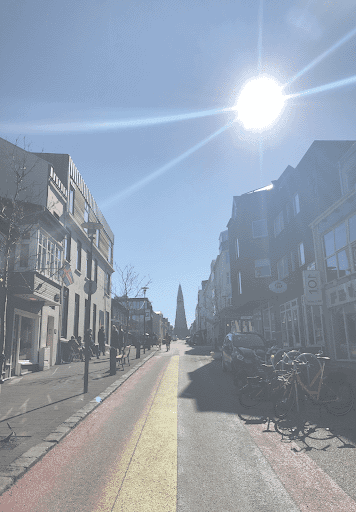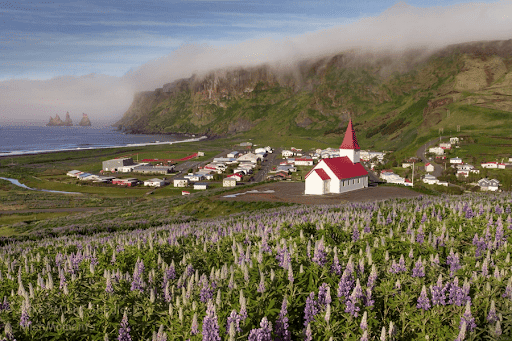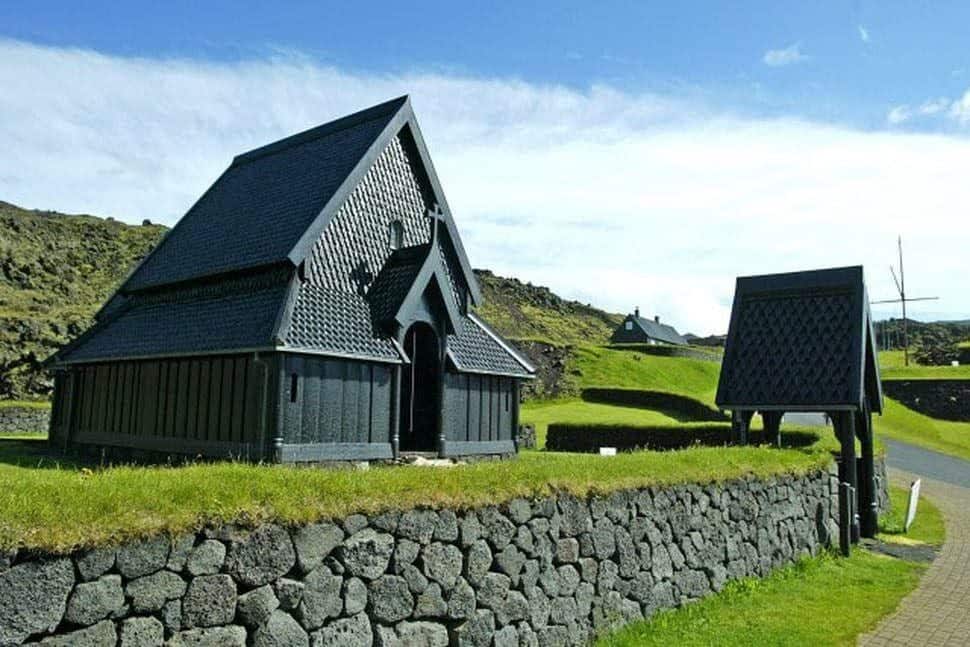In Iceland you will find more than 350 churches all over the island. With a population of around 360.000 people in 2020 this is not a low number.
When Icelanders are born, they are mostly registered as Christians into the Lutheran church of Iceland. At the age of 14 they are confirmed (in Icelandic „Ferming“) and go therefore “into the adulthood”. Whether you are a part of that religion or not, these buildings are still beautiful to look at.
In Iceland, churches are found everywhere
– in all cities, towns and even in the most random spots in the middle of nowhere…

The history of Christianity in Iceland goes back to the first Irish hermit settlers in the early Middle Ages, around 100 years before the Northmen came to the island. The adoption of Christianity came as a compromise of the Heathen and Christian leaders. “Kirkja” is the word for church in Icelandic. And even though most Icelanders do not attend Church Services regularly, they give a high respect to their part in the Icelandic history and a high regard for the church’s beauty and maintenance.
To get the chance to gaze some of Iceland´s churches from the inside, you have to check the local opening hours.
One of Iceland´s earliest churches is located in Þingvellir National Park, one of the most visited places in Iceland. It was built in 1859 and contains bells from the original in 1015 built wooden Church by King Olaf II from Norway.

Photo: Reykjavik Excursions Blog — Þingvellir
A popular photographed Church is the “Búðakirkja”, the black Church from Búðir on Snæfellsnes Peninsula. You will find an incredible picturesque area around Búðakirkja, due to lava fields, the beach and Icelandic green grass and moss all around. Búðir used to be a rich fishing hamlet and trading venue since 1703.
Further East, in Seyðisfjörður you can visit one of the island most beautiful churches. The blue Church, or as Icelander´s say “Bláan Kirkjan” or “Seyðisfjarðarkirkja”. The name is self-explanatory – see photo below. First the church stood on a hill above Vestdalseyri but in 1894 it was blown over and damaged by a huge storm. The Church was rebuilt but later, in 1920 the decision was made to move it to its present location. In 1989 the church was damaged by a fire during some renovation works. Nature took its toll on this special religious place.
The Blue Church is open for visitors from June – August. Check opening hours at www.visitseydisfjordur.com/activity/blaa-kirkjan/


Photos: TripAdvisor
The Church in Vík might be one of the most famous churches in Iceland. The village of Vík (full name Vík í Mýrdal) is the southernmost and a very popular town in Iceland, right around the corner of Reynisfjara, the breathtaking Blacksand beach. Due to Vík´s close location to Katla volcano, south of the Mýrdalsjökull, the population is trained to rush to the church first in case of any eruption. The reason for that is, that Víkurkirkja is located on the highest point in the area and it is believed that it is also the only building that would survive Katla´s Lava flood.
 Photo: MishMoments
Photo: MishMoments
Iceland´s “Capital of the North” is without doubt Akureyri. And “Akureyrarkirkja” is the symbol of the city and located in the Centre. It was designed by the famous architect Guðjón Samúelsson (1887–1950) and completed in 1940. Inside the Church a ship is hanging from the ceiling which reflects an old Nordic tradition of giving offerings for the protection of loved ones at sea and a reminder of those lost at sea. The Church also features a large pipe organ, 3.200 pipes in total. Check opening hours at www.visitakureyri.is/en/see-and-do/attractions/akureyri-church

Photo: visitakureyri.is
The Stafkirkjan in Heimaey was a gift from Norway to Iceland in connection to the millennial anniversary of the conversion of Iceland to Christianity by Olav Tryggvasson in the year 1000. It is a replication of Haltdalen Stave Church in Norway and located in the harbor from Heimaey on the Vestmannaeyjar (Westmen Islands), an area formed by lava of the 1973 eruption of Eldfell volcano. A gallery was added around the outside of the building, inspired by other stave churches, to provide the building against the stormy weather of the Vestmannaeyjar.
Stafkirkjan Heimaey, Photo: mbl.is

Haltdalen Stavkirke, Photo: visitnorway.no
Churches in Skagafjörður
Víðimýrarkirkja is one of Iceland´s few turf churches and still in use. The Church was built in 1834 by the politician and member of the Althingi, Jón Samsonarsson. The exterior sides and the roof are covered with turf, the front and backside have wooden facades. Víðimýrarkirkja is open for visitors daily from 9 am to 6 pm from 1st of June until 31st of August. But it can be opened at other times by arrangement with the caretakers, Einar Örn Einarsson, phone 849 5674 or 453 5095, and Sigríður Stefánsdóttir, phone 899 2053.

Photo: Regina Hrönn, Guide to Iceland
The oldest turf church in Iceland is The Grafarkirkja, located in Höfðaströnd, the eastern Part of Skagafjörður is the oldest church in Iceland with turf. The infinity swimming pool of Hofsós with a breathtaking view is close by. The oldest account on Grafarkirkja is from around 1240 and can be found in Sturlunga Saga, which is a collection of Icelandic Sagas from the 12th and 13th centuries. Probably most turf churches in Iceland were similar to Grafarkirkja in old times. Looking at this church is like looking back in time. Due to the increased traffic, the church has been closed for visitors. Built from timber and turf, the church cannot withstand too much traffic and must be preserved as best as possible. For outside look: GPS: 65°52’10.7″N 19°22’05.9″W

Photo: trover.com
Árbæjarkirkja was originally built in Skagafjörður, but was moved to Árbæjarsafn, the Open-Air Museum in Reykjavík. The Church was restored to its original image and made a part of the Museum in 1960. For more information: www.reykjavikcitymuseum.is/arbaer-open-air-museum or www.borgarsogusafn.is/arbaejarsafn

Photo: borgarsogusafn.is
Now we have more than 340 Icelandic churches left in Iceland to talk about. But we should give attention to our “Grande Dame” or “the Guard” over Reykjavík City. Hallgrímskirkja is a Lutheran parish church and named after the Icelandic poet and clergyman Hallgrímur Pétursson (1614-1674). It is the largest church in Iceland with 74,5 metres (244 ft) high and was designed by Guðjón Samúelsson to resemble the trap rocks, mountains and glaciers of Iceland´s landscape. It took 41 years to build the church; the construction started in 1945 and ended in 1986. The church has a large pipe organ by the German organ builder Johannes Klais from Bonn. It is 15 metres (49 ft) tall and there are 102 ranks, 72 stops and 5.275 pipes. The church is also used as an observation tower. There is no greater view over Reykjavík’s colorful houses and the surroundings, which can be enjoyed by taking a lift up to the viewing deck. The statue of Leifur Eriksson (c. 970 – c. 1020) in front of the church was a gift from the United States in Honor of the 1.000th anniversary of Iceland´s parliament Þingvellir in 1930.

